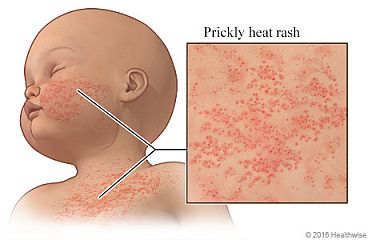Learning About Rashes and Skin Conditions in Newborns

What rashes and skin conditions might your newborn have?
It's very common for newborns to have rashes or other skin conditions. Some of them have long names that are hard to say and sound scary. But most are harmless and will go away on their own in a few days or weeks. Here are some of the things you may notice about your new baby's skin.
Rash
- Heat rash, sometimes called prickly heat or miliaria, is a red or pink itchy rash on the body areas covered by clothing. This rash can happen when your baby is dressed too warmly. It can happen anytime in very hot weather.
- Diaper rash is red, sore skin on a baby's bottom or genitals that is caused by wearing a wet diaper for a long time. Urine and stool from a wet diaper can irritate your baby's skin. Sometimes an infection from bacteria or yeast can also cause diaper rash.
- A rash around the mouth or on the chin that comes and goes is caused by something your newborn probably does a lot: drooling and spitting up.
Pimples
- Baby acne may appear on your baby's cheeks, nose, and forehead during the first few weeks of life. It usually clears up on its own within a few months. It has nothing to do with getting acne as a teenager.
- Tiny white bumps, called milia, may appear on your newborn's face and will go away in a few weeks.
Blotchy skin
- Red blotches with tiny bumps that sometimes contain pus may appear during your baby's first day or two. The blotchy areas may come and go, but they will usually go away on their own within a week. If they don't, your doctor will want to look at them.
- A rash with pus-filled pimples, called pustular melanosis, is common among black infants. The rash is harmless and doesn't need treatment. It usually goes away after the first few days of life. The dark spots that form when the pimples break open may last for a few weeks or months.
- A blotchy, lace-like rash (mottling) may appear when your baby is cold. The mottling is your baby's reaction to being in a cold place. Remove your baby from the cold source, and the rash will usually go away. If it is still there when your baby is warmed, it should be checked by a doctor. It usually doesn't happen past 6 months of age.
Tiny red dots
- These red dots, called petechiae (say "puh-TEE-kee-eye"), are specks of blood that leaked into the skin at birth when your baby squeezed through the birth canal. They will go away within the first week or two. If they started after birth, your doctor should check them.
Scaly scalp
- Cradle cap, also called seborrheic dermatitis (say "seh-buh-REE-ick der-muh-TY-tus"), is a scaly or crusty skin on the top of your baby's head. It's a normal buildup of sticky skin oils, scales, and dead skin cells. Cradle cap is harmless and will not spread to others. It usually goes away by your baby's first birthday.
How can you prevent and treat the rash or skin condition?
Many of the rashes and skin conditions you may see in your newborn will come and go without any treatment from you. Others can be prevented or treated.
- Dress your child in cotton clothing. Do not use wool and synthetic fabrics next to the skin.
- Use gentle soaps, and use as little as possible. Do not use deodorant soaps on your child.
- Wash your child's clothes with a mild soap, such as Cheer Free and Gentle or Ecover, rather than a detergent. Rinse twice to remove all traces of the soap. Do not use strong detergents.
- Leave the rash open to the air whenever possible.
- Do not let the skin become too dry, which can make itching worse.
- If your doctor prescribed a cream, apply it to your child's skin as directed. If your doctor prescribed medicine, give it exactly as directed. Call your doctor or nurse advice line if you think your child is having a problem with his or her medicine.
Diaper rash
- Change diapers as soon as they are wet or dirty. Before you put a new diaper on your baby, gently wash the diaper area with warm water. Rinse and pat dry.
- Wash your hands before and after each diaper change.
- Air the diaper area for 5 to 10 minutes before you put on a new diaper.
- Do not use baby powder while your baby has a rash. The powder can build up in the skin folds and hold moisture. This lets bacteria grow.
- Protect your baby's skin with A+D Ointment, Desitin, or another diaper cream.
Heat rash
- Dress your child in as few clothes as possible during hot weather.
- Keep your child's skin cool and dry.
- Keep your child's sleeping area cool.
When should you call for help?
Call your doctor or nurse advice line now or seek immediate medical care if:
- Your child becomes very fussy.
- Your child has blisters, open sores, or scabs in the area of the rash.
- Your child has symptoms of infection, such as:
- Increased pain, swelling, warmth, or redness around the rash.
- Red streaks leading from the rash.
- Pus draining from the rash.
- A fever.
Watch closely for changes in your child's health, and be sure to contact your doctor or nurse advice line if:
- Your child's rash gets worse.
- Your child does not get better as expected.
Where can you learn more?
Go to https://www.healthwise.net/patientEd
Enter S986 in the search box to learn more about "Learning About Rashes and Skin Conditions in Newborns".
Current as of: October 24, 2024
